Basketball Defense - 2-2-1 Zone Press
From the Coach’s Clipboard Basketball Playbook"Helping coaches coach better..."
Disclosure: This page contains affiliate links, which means that Coach's Clipboard receives a small commission (at no cost to you) if you make a purchase using these links.

Before proceeding with this page, read "Transition Defense", on full court defense.
Set up the 2-2-1 zone press like this (see Diagram A). Have two players set at both ends of the free throw line. Two other defenders should be positioned just inside the half-court line, and the fifth player plays "prevent".
The inbounds pass is not contested or guarded. Do not allow a pass in the middle of the floor. The defenders X1 and X2 should allow the pass to a receiver near the corner. They should wait until the ball-handler commits and starts dribbling.
Once the dribble is started, they should attack and trap him/her near the sideline (Diagram B). The other two defenders then position themselves in the passing lanes to other would-be receivers and look for the interception. The X5 defender should only come up if he/she has a clear-cut interception.
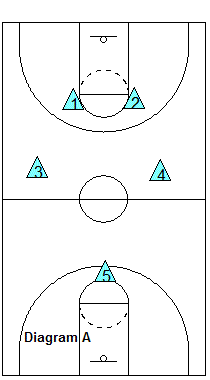
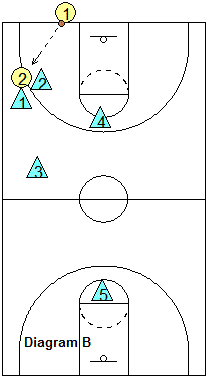
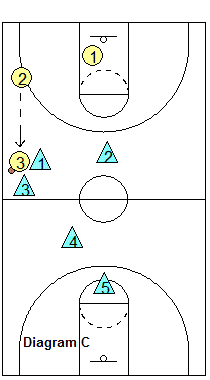
If the ball gets part way up the sideline, the mid-court defender (X3 or X4) should stop the penetration along the sideline, and trap the ball-handler along with the guard from that side (X1 or X2). Now the opposite guard and mid-court defenders play the passing lanes (see Diagram C).
Oakland University coach Greg Kampe (see video below) wants the ball stopped and trapped along the sideline at half-court. If the ball is dribbled up the sideline, X1 and X2 should stop it and trap it, as X3 drops back to prevent the sideline pass. If the ball is passed up the sideline, then X3 and X1 trap.
Allow a backward, retreating pass, as the 10-second rule is in your favor. If the ball moves to the opposite side, the traps and zones are set on that side the same as described above, only with the opposite defenders positioned as above. The defenders should never let the ball get ahead of them on the court. If that happens, they must sprint down-court quickly to recover.
Once the press is broken, or the offense crosses mid-court, all defenders not on the ball should sprint back to the paint to protect basket (unless there is an easy trap in the sideline, mid-court line corner). The on-ball defender should stay on the ball and stop dribble penetration.
There are variations and adjustments to this basic zone, depending on how the offense uses their point guard... i.e. whether he/she tries to receive the inbounds pass, or make the inbounds pass and then receive the ball right back.
2-2-1 Zone Press Adjustments
Here are a couple of variations on the 2-2-1 zone press.
2-Up Zone Press
The "2-up" zone press is used against teams who have their best ball-handler make the inbounds pass, and then step inbounds and receive the pass right back. We want to keep the ball out of the hands of the best ball-handler, and have someone bring it up who is not comfortable in that role, thereby increasing the chance of a turnover.See Diagram A. In this case, the X2 defender will deny the pass back to the inbounder, and will play him/her man-to-man, in full denial. The other four defenders essentially play a zone.
X3 will prevent the sideline pass, and X4 prevents the middle pass.
The weak side of the court is open and X5 might be able to anticipate a long cross-court pass there, or a long down-court pass. Long passes are often thrown out-of-bounds, or are intercepted. But again remember, all zone presses have an element of risk, and are a gamble.
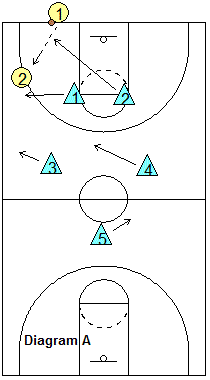
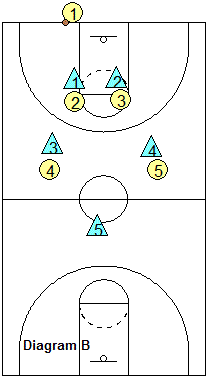
2-2-1 "Deny" Defense
With this full-court press, we try to deny the inbounds pass and get the 5-second call. This can be used against a team that tries to make the inbounds pass to their best ball-handler. See Diagram B.In this defense, don't guard the passer. Instead, place your X5 back in "prevent", to protect against the long pass and lay-up. The other four defenders match up with the other four offensive players and play full denial, trying to prevent the inbounds pass. Until the ball is passed inbounds, you have a 5 on 4 situation, with five defenders and only four offensive receivers.
The offense may try to screen to get a man open. Be ready for the quick switch, or fight through.
The offense may try to run their O4 and O5 toward the passer for a quick pass. Defenders X3 and X4 must stay between them and the passer to deny this pass.
Often defenders X3 and X4 are worried about getting beat by the long pass over their heads, but defender X5 should be back to cover the long pass. This is the advantage of not guarding the passer, but rather having X5 protect against the long pass.




